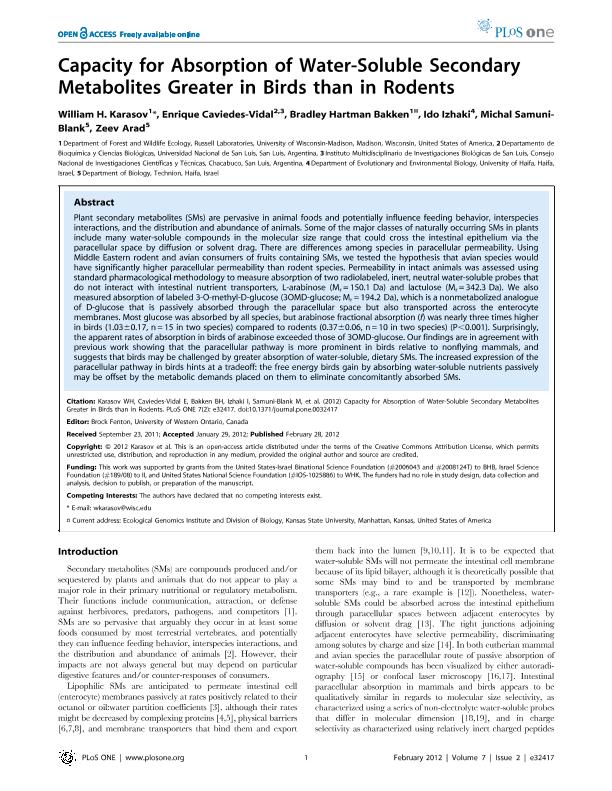Artículo
Capacity for absorption of water-soluble secondary metabolites greater in birds than in rodents
Karasov, William; Caviedes Vidal, Enrique Juan Raul ; Bakken, Bradley Hartman; Izhaki, Ido; Samuni Blank, Michal; Arad, Zeev
; Bakken, Bradley Hartman; Izhaki, Ido; Samuni Blank, Michal; Arad, Zeev
 ; Bakken, Bradley Hartman; Izhaki, Ido; Samuni Blank, Michal; Arad, Zeev
; Bakken, Bradley Hartman; Izhaki, Ido; Samuni Blank, Michal; Arad, Zeev
Fecha de publicación:
02/2012
Editorial:
Public Library of Science
Revista:
Plos One
ISSN:
1932-6203
Idioma:
Inglés
Tipo de recurso:
Artículo publicado
Clasificación temática:
Resumen
Plant secondary metabolites (SMs) are pervasive in animal foods and potentially influence feeding behavior, interspecies interactions, and the distribution and abundance of animals. Some of the major classes of naturally occurring SMs in plants include many water-soluble compounds in the molecular size range that could cross the intestinal epithelium via the paracellular space by diffusion or solvent drag. There are differences among species in paracellular permeability. Using Middle Eastern rodent and avian consumers of fruits containing SMs, we tested the hypothesis that avian species would have significantly higher paracellular permeability than rodent species. Permeability in intact animals was assessed using standard pharmacological methodology to measure absorption of two radiolabeled, inert, neutral water-soluble probes that do not interact with intestinal nutrient transporters, L-arabinose (M r = 150.1 Da) and lactulose (M r = 342.3 Da). We also measured absorption of labeled 3-O-methyl-D-glucose (3OMD-glucose; M r = 194.2 Da), which is a nonmetabolized analogue of D-glucose that is passively absorbed through the paracellular space but also transported across the enterocyte membranes. Most glucose was absorbed by all species, but arabinose fractional absorption (f) was nearly three times higher in birds (1.03±0.17, n = 15 in two species) compared to rodents (0.37±0.06, n = 10 in two species) (P<0.001). Surprisingly, the apparent rates of absorption in birds of arabinose exceeded those of 3OMD-glucose. Our findings are in agreement with previous work showing that the paracellular pathway is more prominent in birds relative to nonflying mammals, and suggests that birds may be challenged by greater absorption of water-soluble, dietary SMs. The increased expression of the paracellular pathway in birds hints at a tradeoff: the free energy birds gain by absorbing water-soluble nutrients passively may be offset by the metabolic demands placed on them to eliminate concomitantly absorbed SMs.
Archivos asociados
Licencia
Identificadores
Colecciones
Articulos(IMIBIO-SL)
Articulos de INST. MULTIDICIPLINARIO DE INV. BIO. DE SAN LUIS
Articulos de INST. MULTIDICIPLINARIO DE INV. BIO. DE SAN LUIS
Citación
Karasov, William; Caviedes Vidal, Enrique Juan Raul; Bakken, Bradley Hartman; Izhaki, Ido; Samuni Blank, Michal; et al.; Capacity for absorption of water-soluble secondary metabolites greater in birds than in rodents; Public Library of Science; Plos One; 7; 2; 2-2012; 32417-32417
Compartir
Altmétricas



